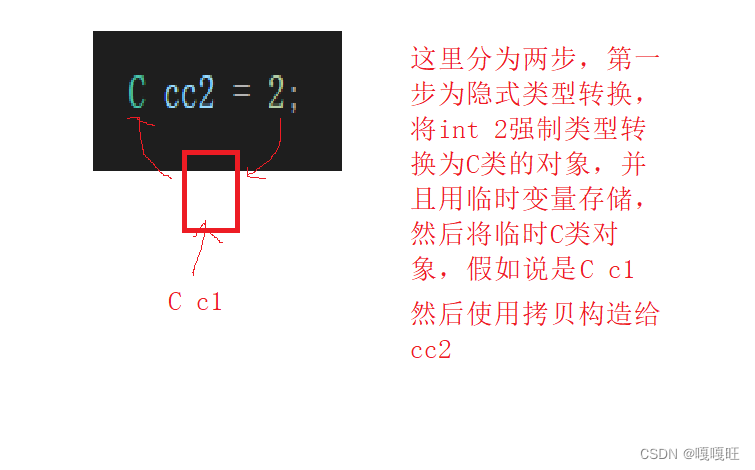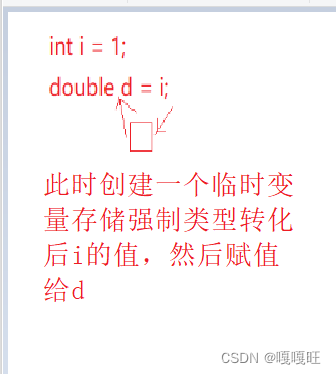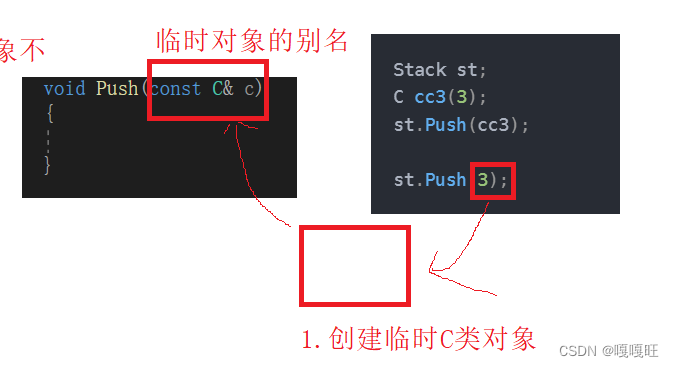日期类的拓展
c语言中的printf函数只能打印内置类型,为了弥补这一不足,c++利用运算符重载可以打印自定义类型。
void operator<<(ostream&out);//声明在date.h中
void Date::operator<<(ostream& out)//定义在date.cpp中
{out<<this->_year <<"年" << this->_month<<"月" << this->_day<<"日";}
int main()//.cpp中
{Date d1(2024, 3, 30);d1.operator<<(cout);}
如果我们修改成这样呢.cpp
int main()
{Date d1(2024, 3, 30);//d1.operator<<(cout);cout << d1;}

由于我们的运算符重载是定义在日期类里面的,所以默认*this是左操作数,所以类定义的对象必须放在左边。修改如下:
int main()
{Date d1(2024, 3, 30);//d1.operator<<(cout);d1<<cout;
}
如果我们就要使类对象在右边呢?
所以我们必须将该函数放在全局,但是放在全局的话,类对象的变量都是私有,就不能访问到,我们先改成共有:
void operator<<(ostream& out, Date& d);//声明放全局在date.h中
void operator<<(ostream& out, Date& d)//定义在date.cpp中
{out << d._year << "年" << d._month << "月" << d._day << "日";}
int main()//在.cpp中
{Date d1(2024, 3, 30);//d1.operator<<(cout);cout<<d1;}
如果我们不将变量改成共有,我们全局函数怎么才能访问到类成员变量呢?
friend void operator<<(ostream& out, Date& d);
在声明中加上这个,使全局的函数成为类的友元函数,就可以访问类的变量了。
我们知道变量可以连续赋值,这里可以支持连续输出吗?

赋值运算符从右向左,先把q的值赋值为10,然后再把q的值赋给p,然后把p的值赋给i,实现连续赋值,因此需要返回值
ostream& operator<<(ostream& out, Date& d)//定义
{out << d._year << "年" << d._month << "月" << d._day << "日";return out;}
ostream& operator<<(ostream& out, Date& d);//声明
int main()
{Date d1 = (2002, 3, 11);Date d2 = (2012, 3, 11);cout << d1 << d2;}
既然能输出自定义类型,那怎么使用运算符重载函数实现自定义类型输入呢?
实现如下:
istream& operator>>(istream& in, Date& d);//声明在date.h全局
istream& operator>>(istream& in, Date& d)//date.cpp定义
{in>>d._year >> d._month >> d._day ;return in;}
int main()
{Date d1 ;Date d2 ;cin >> d1 >> d2;//给输入cout << d1 << d2;//输出}
日期类的安全性修改
比如,如果输入不合法,就提示,我们需要写一个检测的函数
修改后的日期类
date.h
#pragma once
#include<iostream>
using namespace std;
class Date{public:// 获取某年某月的天数int GetMonthDay(int year, int month);// 全缺省的构造函数Date(int year = 1900, int month = 1, int day = 1);// 拷贝构造函数// d2(d1)Date(const Date& d);// 赋值运算符重载// d2 = d3 -> d2.operator=(&d2, d3)Date& operator=(const Date& d);// 析构函数~Date();// 日期+=天数Date& operator+=(int day);// 日期+天数Date operator+(int day);// 日期-天数Date operator-(int day);// 日期-=天数Date& operator-=(int day);// 前置++Date& operator++();// 后置++Date operator++(int);// 后置--Date operator--(int);// 前置--Date& operator--();// >运算符重载bool operator>(const Date& d);// ==运算符重载bool operator==(const Date& d);// >=运算符重载bool operator >= (const Date& d);// <运算符重载bool operator < (const Date& d);// <=运算符重载bool operator <= (const Date& d);// !=运算符重载bool operator != (const Date& d);bool isvalid(Date& d);// 日期-日期 返回天数int operator-(const Date& d);void print();/*void operator<<(ostream&out);*/friend ostream & operator<<(ostream& out, Date& d);friend istream& operator>>(istream& in, Date& d);
private:int _year;int _month;int _day;};
ostream& operator<<(ostream& out, Date& d);
istream& operator>>(istream& in, Date& d);date.cpp
#include "date.h"
Date::Date(int year, int month, int day)
{_year = year;_month = month;_day = day;if (!(this->isvalid(*this))){cout << "初始化非法" << endl;}}
void Date:: print()
{cout << _year << "." << _month << "." << _day<<endl;
}
Date::Date(const Date& d)
{_year = d._year;_month = d._month;_day = d._day;}
Date::~Date()
{_year = 0;_month = 0;_day = 0;}
int Date:: GetMonthDay(int year, int month)
{int arr[13] = { 0,31,28,31,30,31,30,31,31,30,31,30,31 };if (month == 2 && (year % 4 == 0 && year % 100 != 0 || year % 400 == 0)){return 29;}return arr[month];}
Date& Date:: operator=(const Date& d)
{if (this != &d){_year = d._year;_month = d._month;_day = d._day;}return *this;}
Date & Date::operator+=(int day)
{_day+= day;while (_day > GetMonthDay(_year,_month)){_day -= GetMonthDay(_year, _month);_month++;if (_month == 13){_month = 0;}}return *this;}
Date Date:: operator+(int day)
{Date tmp = *this;tmp._day += day;while (tmp._day > GetMonthDay(tmp._year, tmp._month)){tmp._day -= GetMonthDay(tmp._year, tmp._month);tmp._month++;if (tmp._month == 13){tmp._month = 0;}}return tmp;}
Date& Date:: operator-=(int day)
{_day -= day;while (_day <= 0){_month--;if (_month == 0){_year--;_month = 12;}_day += GetMonthDay(_year, _month);}return *this;}
Date Date::operator-(int day)
{Date tmp = *this;tmp -= (day);return tmp;}
bool Date:: operator>(const Date& d)
{if (_year > d._year){return true;}else{if (_year == d._year){if (_month > d._month){return true;}else{if (_month == d._month){if (_day > d._day)return true;}}}}return false;}
bool Date::operator==(const Date& d)
{return (_year == d._year) && (_month == d._month) &&( _day == d._day);}
bool Date:: operator >= (const Date& d)
{return *this > (d) || *this == (d);}bool Date:: operator < (const Date& d)
{return !(*this >= (d));}
bool Date::operator <= (const Date& d)
{return !(*this>(d));}
bool Date:: operator != (const Date& d)
{return !(*this==(d));}Date& Date::operator++()
{*this = *this + 1;return *this;}Date Date:: operator++(int)
{Date tmp = *this;*this=*this+ 1;return tmp;}Date Date::operator--(int)
{Date tmp =*this;*this=*this-1;return tmp;}
Date& Date:: operator--()
{*this = *this - 1;return *this;}int Date::operator-(const Date& d)
{Date max = *this;Date min = d;int flag = 1;if (min > (max)){max = d;min = *this;flag = -1;}int n = 0;while (max != min){n++;min++;}return flag*n;}
bool Date::isvalid(Date& d)
{if (_year < 0 || _month <= 0 || _month>12 || _day<1 || _day>GetMonthDay(_year, _month)){return false;}true;}
ostream& operator<<(ostream& out, Date& d)
{out << d._year << "年" << d._month << "月" << d._day << "日";return out;}
istream& operator>>(istream& in, Date& d)
{while (1){cout << "请输入时间" << endl;in >> d._year >> d._month >> d._day;if (!d.isvalid(d)){cout << "输入不合法" << endl;}else{break;}}return in;
}权限问题
首先看一个问题


我们这里调用print函数发现调用不动

应该怎么修改呢?
在printhan函数的声明和定义后面加上const
void Date:: print() const//定义
{cout << _year << "." << _month << "." << _day<<endl;
}
void print() const;//声明
此时该函数中*this指向的内容不能被修改。现在调用相当于权限平移,就可以了。
此时我们的print函数时加了const
int main()
{Date d1 ;Date d2(2003,3,3);const Date d3(2002,1,2);d3.print();d2.print();}
d2是非const的类对象,也能调用const函数print,因为权限缩小了,所以可以。
总结:
成员函数,如果是一个对成员变量只进行读访问的函数,建议函数+const,这样const对象和非const对象都可以使用
如果一个对成员变量要进行读写访问的函数,不能加const,否则不能修改成员变量
- const对象可以调用非const成员函数吗? 权限放大
- 非const对象可以调用const成员函数吗? 权限缩小
- const成员函数内可以调用其它的非const成员函数吗?权限放大
- 非const成员函数内可以调用其它的const成员函数吗?权限缩小
权限放大和缩小和平移适用于指针和引用
取地址及const取地址操作符重载
这两个默认成员函数一般不用重新定义 ,编译器默认会生成。
class Date
{
public :Date* operator&(){return this ;}const Date* operator&()const{return this ;}
private :int _year ; // 年int _month ; // 月int _day ; // 日
};
这两个运算符一般不需要重载,使用编译器生成的默认取地址的重载即可,只有特殊情况,才需要重载,比如想让别人获取到指定的内容!
初始化列表
在创建对象时,编译器通过调用构造函数,给对象中各个成员变量一个合适的初始值。
class Date
{
public:
Date(int year, int month, int day){_year = year;_month = month;_day = day;_year=1;}
private:
int _year;
int _month;
int _day;
};
虽然上述构造函数调用之后,对象中已经有了一个初始值,但是不能将其称为对对象中成员变量的初始化,构造函数体中的语句只能将其称为赋初值,而不能称作初始化。因为初始化只能初始化一次,而构造函数体内可以多次赋值。
初始化列表:以一个冒号开始,接着是一个以逗号分隔的数据成员列表,每个"成员变量"后面跟一个放在括号中的初始值或表达式。
class Date
{
public:
Date(int year, int month, int day): _year(year), _month(month), _day(day){}
private:
int _year;
int _month;
int _day;
};
因为我们的常量,引用必须在定义的时候初始化。
#include<iostream>
using namespace std;
class Date
{
public:Date(int year, int month, int day){_year = year;_month = month;_day = day;_year = 1;n = 1;}
private:int _year;int _month;int _day;const int n;
};int main(){Date d1(2003, 3, 11);}

所以我们常量初始化一定要放在初始化列表中。
#include<iostream>
using namespace std;
class Date
{
public:Date(int year, int month, int day):n(1), _year(year), _month(month), _day(day){}
private:int _year;int _month;int _day;const int n;
};int main(){Date d1(2003, 3, 11);}
引用类型必须在初始化时候给初值
#include<iostream>
using namespace std;
class Date
{
public:Date(int year, int month, int day,int&p):n(3), _year(year), _month(month), _day(day),x(p){}
private:int _year;int _month;int _day;const int n=1;int& x;
};int main(){int num = 5;Date d1(2003, 3, 11,num);}
p是num的别名,而x又是p的别名。
3.当我们类成员变量里面有自定义类型的话,并且我们没有在初始化列表初始化,初始化列表会给他调用他自己的默认构造函数完成初始化。(这里的默认构造是我们写的全缺省构造函数)
#include<iostream>
using namespace std;
class A
{
public:A(int a=3):_a(a){cout << "调用" << endl;}
private:int _a;
};
class Date
{
public:Date(int year, int month, int day,int&p):n(3), _year(year), _month(month), _day(day),x(p){}
private:int _year;int _month;int _day;const int n=1;int& x;A cou;
};int main(){int num = 5;Date d1(2003, 3, 11,num);}
如果A dou对象没有默认构造呢(默认构造包括全缺省,无参,系统生成的,这里构造有参,所以没有默认构造)
我们可以在初始化列表给自定义类型初始化。
#include<iostream>
using namespace std;
class A
{
public:A(int a):_a(a){cout << "调用" << endl;}
private:int _a;
};
class Date
{
public:Date(int year, int month, int day,int&p):n(3), _year(year), _month(month), _day(day),x(p),cou(5){}
private:int _year;int _month;int _day;const int n=1;int& x;A cou;
};int main(){int num = 5;Date d1(2003, 3, 11,num);}

【注意】
- 每个成员变量在初始化列表中只能出现一次(初始化只能初始化一次)
- 类中包含以下成员,必须放在初始化列表位置进行初始化:
- 引用成员变量
- const成员变量
- 自定义类型成员(且该类没有默认构造函数时)
同时也可以在初始化列表给指针初始化,可以在初始化列表中检查空间是否申请
#include<iostream>
#include<stdlib.h>
using namespace std;
class A
{
public:A(int a):_a(a){cout << "调用" << endl;}
private:int _a;
};
class Date
{
public:Date(int year, int month, int day,int&p):n(3), _year(year), _month(month), _day(day),x(p),cou(5),ptr((int*)malloc(sizeof(int))){if (ptr == NULL){perror("malloc fail");}}
private:int _year;int _month;int _day;const int n=1;int& x;A cou;int* ptr;
};int main(){int num = 5;Date d1(2003, 3, 11,num);}
总结:声明的缺省参数是给初始化列表的,如果初始化列表没有给一个变量初始化,这个变量就拿的是缺省参数的值,自定义类型如果初始化列表没有初始化,就会去调用自己的默认构造函数,来进行初始化,如果没有默认构造函数的话,就要看对象实例化的时候有没有给自己写的构造函数有没有传值,如果没有的话,就是随机值,如果初始化列表给自定义类型初始化了,就没有上面的一系列操作了,初始化列表后还可以在括号里面给变量赋值(除了那3个)相当于构造函数。
单参数构造函数支持隐式类型转换
#include<iostream>
#include<stdlib.h>
using namespace std;
class C
{
public:C(int x = 0):_x(x){}C(const C& cc){cout << "C(const C& cc)" << endl;}private:int _x;
};
int main()
{C cc2 = 2;}

编译器优化,连续步骤的·构造,一般会合二为一
和隐式类型转化差不多

如果我们的自定义的对象没有在初始化列表中初始化,并且也没有自己的默认构造函数的话,我们要给缺省值给自定义对象赋值,我们必须在全局实例化一个类对象,然后将该类对象拷贝构造给里面的自定义变量。
#include<iostream>
#include<stdlib.h>
using namespace std;
class C
{
public:C(int x = 0):_x(x){}C(const C& cc){cout << "C(const C& cc)" << endl;}private:int _x;
};
class Stack
{
public:void Push(const C& c){}
};int main()
{Stack st;C cc3(3);st.Push(cc3);st.Push(3);return 0;
}
这里如果我们要入一个C类的对cc3,并且cc3类成员变量初始化为3,本来我们需要先给cc3对象赋值,然后再将C类对象cc3入栈,现在支持单参数构造函数支持隐式类型转换,就可以入栈一个类成员变量初始化为3,并且是C类对象。

c++11支持多参数构造函数支持隐式类型转换
#include<iostream>
#include<stdlib.h>
using namespace std;
class A
{
public:A(int a1, int a2):_a1(a1),_a2(a2){}private:int _a1;int _a2;
};int main()
{A aa1 = { 1, 2 };return 0;
}
explicit关键字
#include<iostream>
#include<stdlib.h>
using namespace std;
class A
{
public:explicit A(int a1, int a2):_a1(a1),_a2(a2){}private:int _a1;int _a2;
};int main()
{A aa1 = { 1, 2 };return 0;
}
用explicit修饰构造函数,将会禁止构造函数的隐式转换。
成员变量在类中声明次序就是其在初始化列表中的初始化顺序,与其在初始化列表中的先后次序无关
class A
{
public:A(int a):_a1(a),_a2(_a1){}void Print() {cout<<_a1<<" "<<_a2<<endl;}
private:int _a2;int _a1;
};
int main() {A aa(1);aa.Print();
}
上述代码会出现什么情况?D
A. 输出1 1
B.程序崩溃
C.编译不通过
D.输出1 随机值
因为是按照声明次序初始化,所以_a2初始化的时候,_a1还没有初始化,所以_a2是随机值,然后_a1按照初始化列表初始化为1
static成员
概念
声明为static的类成员称为类的静态成员,用static修饰的成员变量,称之为静态成员变量;用static修饰的成员函数,称之为静态成员函数。静态成员变量一定要在类外进行初始化
class A
{
public:A(){}A(const A& aa){}private:int a = 0;
};A Func()
{A aa;return aa;
}int main()
{A aa1;A aa2;Func();return 0;
}
实现一个类,计算程序中创建出了多少个类对象
1.我们定义一个全局变量统计构造函数和拷贝构造函数调用了多少次
#include<iostream>
#include<stdlib.h>
using namespace std;
int n = 0;
class A
{
public:A(){n++;}A(const A& aa){n++;}private:int a = 0;
};A Func()
{A aa;return aa;
}int main()
{A aa1;A aa2;Func();cout << n << endl;return 0;
}
2.由于全局变量可以在任意位置被修改,我们将n定义在类中,但是类中的n是私有的,我们可以使用静态变量static,然后去掉私有,但是static 必须在类外面定义初始化,这时候n就可以在每个类对象中使用了(突破类域使用n)
#include<iostream>
#include<stdlib.h>
using namespace std;class A
{
public:A(){n++;}A(const A& aa){n++;}int a = 0;static int n;
};int A::n = 0;A Func()
{A aa;return aa;
}int main()
{A aa1;A aa2;Func();cout << aa1.n << endl;cout << aa2.n << endl;cout << A::n << endl;return 0;
}
3.使用静态函数返回静态变量,静态函数中没有this指针,只能操作静态变量。
#include<iostream>
#include<stdlib.h>
using namespace std;class A
{
public:A(){n++;}A(const A& aa){n++;}static int GetN(){return n;}private:int a = 0;static int n;
};int A::n = 0;A Func()
{A aa;return aa;
}int main()
{A aa1;A aa2;Func();cout << aa1.GetN() << endl;cout << A::GetN() << endl;return 0;
}
特性
- 静态成员为所有类对象所共享,不属于某个具体的对象,存放在静态区
- 静态成员变量必须在类外定义,定义时不添加static关键字,类中只是声明
- 类静态成员即可用 类名::静态成员 或者 对象.静态成员 来访问
- 静态成员函数没有隐藏的this指针,不能访问任何非静态成员
- 静态成员也是类的成员,受public、protected、private 访问限定符的限制
)








原理,常见的串口通信方式有哪些?)


线性回归模型)
![[UI5 常用控件] 05.FlexBox, VBox,HBox,HorizontalLayout,VerticalLayout](http://pic.xiahunao.cn/[UI5 常用控件] 05.FlexBox, VBox,HBox,HorizontalLayout,VerticalLayout)





